


When I think about the power of public speaking activities in building confidence, one story stands out in my mind—the story of Naman.
Naman (name changed) was one of my quieter students, a thoughtful young man with a visible stutter. When he first joined my language class, he was incredibly shy and often sat at the back, avoiding any situation where he might be asked to speak. Even reading aloud was intimidating for him, and his stutter seemed to get worse when he was anxious, leading him to withdraw from group discussions and classroom activities.
The situation was heartbreaking. Naman was bright, with a lot of ideas and opinions, but his confidence was almost nonexistent. I would encourage him as best as I could, but there was only so much I could do within the limits of regular classroom time. Coming from Jammu, we didn’t have much exposure to extracurricular education yet. He told me once, almost in passing, that he wished he could express himself as easily as his classmates did. His eyes said it all—a mixture of frustration and resignation. I knew then that something had to change, and I hoped I’d find a way to help him find his voice.
The breakthrough came when our school introduced Behes, India’s largest school debate platform. I thought Behes might be exactly the environment Naman needed, with its supportive, inclusive atmosphere that encouraged every student to participate. I suggested he come to the first session just to observe. Though initially reluctant, he finally agreed. He was captivated by what he saw. Watching his peers engage passionately in debates, building arguments, and responding respectfully to one another, Naman became intrigued. He admitted to me later that it seemed like something he might actually enjoy, though he couldn’t imagine himself ever debating in front of an audience.
He started small, just listening in at first, then eventually joining group discussions within his team. These low-pressure settings gave him a safe space to speak without feeling exposed, and every time he made it through a thought, even a sentence, without stuttering, I could see a flicker of confidence grow in him. Little by little, he started to believe he could speak in front of others, and his excitement over these small victories was inspiring. Behes became the perfect environment for him to explore his voice without judgment.
I began giving him short public speaking exercises—timed sessions where he’d talk about a simple topic for 30 seconds. At first, he’d stumble, his stutter slowing him down, but he was determined. With practice, he gradually managed to find a rhythm, and the more he practiced, the better he got. Each successful attempt chipped away at his anxiety, giving him a little more courage. He even began practicing in front of friends and family, a huge step for someone who once barely spoke in class.
The real test came when he decided to participate in his first Behes competition, a local event. I’ll never forget how nervous he was that day. His hands shook, his voice wavered, and he stumbled on his words initially. But then, something incredible happened. As he got deeper into his argument, he seemed to forget his fear. He became focused on his thoughts, speaking with a conviction I hadn’t seen before. His stutter was still there, but it no longer held him back; he was more focused on the strength of his ideas than on his speech.
The support from his teammates and the encouragement from his mentors at Behes made all the difference. Naman walked off the stage that day visibly different—more assured, with a spark of confidence that hadn’t been there before. I could see he had turned a corner, realizing he was capable of expressing himself, even with a stutter.
Over the months, Naman kept participating in Behes competitions, gaining momentum with each debate. He progressed from local to regional levels, and his teammates came to rely on his insights and his ability to frame arguments. The once-quiet student was now known for his thoughtful, balanced viewpoints and his tenacity. When he qualified for the national level, it was a surreal moment for both of us. Standing on that stage, representing his school at a national event, Naman was the embodiment of courage and growth. His stutter, though still present, was now just a small part of his identity—a part that he’d come to accept and work with, rather than be defined by.
Reflecting on Naman’s journey has made me realize just how transformative public speaking activities can be. In Naman’s case, they were the bridge between silence and self-expression, helping him to manage his stutter and gain a lasting sense of confidence. Behes gave him a structured environment to grow, filled with support and free of judgment. It’s hard to overstate the power of this supportive space in helping him find his voice and step into the person he’s become.
Seeing Naman’s transformation has reaffirmed my belief in the importance of providing students with platforms like Behes, where they can explore their abilities and overcome personal challenges. His story is a reminder that confidence isn’t about speaking perfectly—it’s about speaking authentically and believing in what you’re saying. And for Naman, that has made all the difference.
Naman’s story has inspired me in my own teaching, showing me that when we give students the right opportunities and the support to grow, they can achieve things they never thought possible. His journey is proof that with patience, resilience, and the courage to keep going, every student has the potential to find their voice.